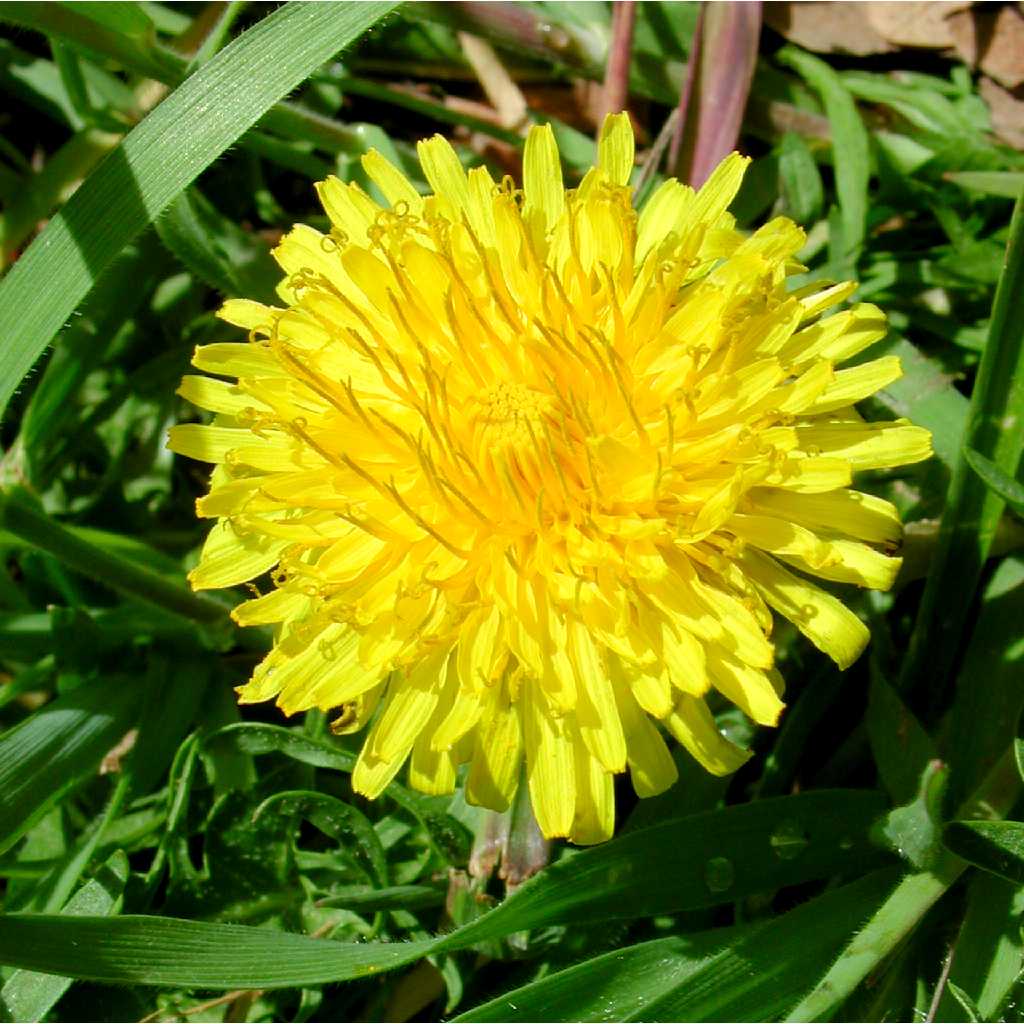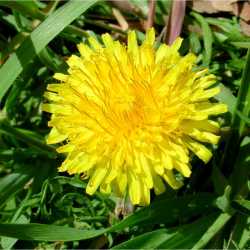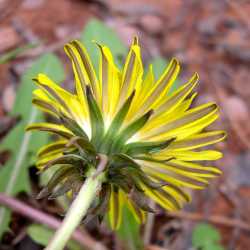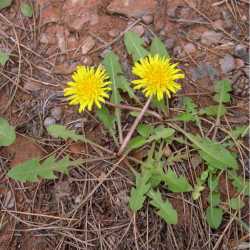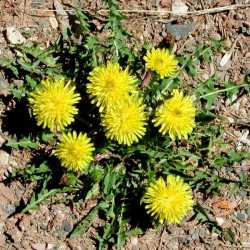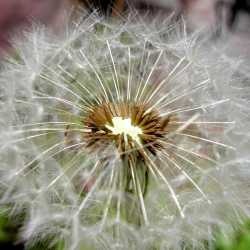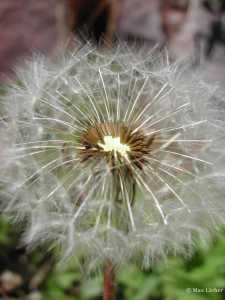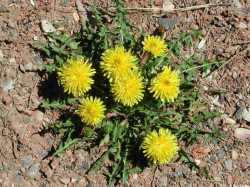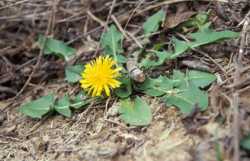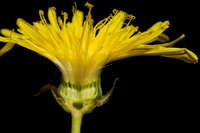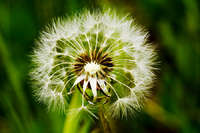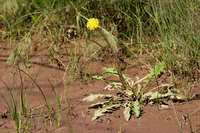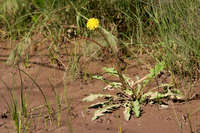Plants (1-)5-40(-60) cm; taproots seldom branched. Stems 1-10+, erect or ascending, sometimes ± purplish (usually equaling or surpassing leaves), glabrous or sparsely villous, slightly more so distally. Leaves 20+, horizontal to erect; petioles ± narrowly winged; blades oblanceolate, oblong, or obovate (often runcinate), (4-)5-45 × (0.7-)1-10 cm, bases attenuate to narrowly cuneate, margins usually shallowly to deeply lobed to lacerate or toothed, lobes retrorse, broadly to narrowly triangular to nearly lanceolate, acute to long-acuminate, terminals ± as large as distal laterals, ultimate margins toothed or entire (secondary lobules irregular, perpendicular to retrorse), teeth minute to pronounced apices acute to acuminate or obtuse, faces glabrous or sparsely villous (commonly on midveins). Calyculi of 12-18, reflexed, sometimes ± glaucous, lanceolate bractlets in 2 series, 6-12 × 2.8-3.5 mm, margins very narrowly white-scarious, sometimes villous-ciliate distally, apices acuminate, hornless. Involucres green to dark green or brownish green, tips dark gray or purplish, campanulate, 14-25 mm. Phyllaries 13-18 in 2 series, lanceolate, 2-2.8 mm wide, margins scarious (proximal 2/3) to narrowly scarious, apices acuminate, erose-scarious, usually hornless (seldom appendaged), callous. Florets 40-100+; corollas yellow (orange-yellow), 15-22 × 1.7-2 mm (outer). Cypselae olivaceous or olive-brown, or straw-colored to grayish, bodies oblanceoloid, (2-)2.5-2.8(-4) mm, cones shortly terete, 0.5-0.9 mm, beaks slender, 7-9 mm, ribs 4-12, sharp, faces proximally smooth to ± tuberculate, muricate in distal 1/3; pappi white to sordid, 5-6(-8) mm. 2n = 24, 40, [16, 32].
Flowering nearly year-round (fall-spring, south; spring or summer, north). Often damp low places, lawns, roadsides, waste grounds, disturbed banks and shores; 0-2000+ m; introduced; Greenland; St. Pierre and Miquelon; Alta., B.C., Man., N.B., Nfld. and Labr., N.W.T., N.S., Nunavut, Ont., P.E.I., Que., Sask., Yukon; Ala., Alaska, Ariz., Ark., Calif., Colo., Conn., Del., D.C., Fla., Ga., Idaho, Ill., Ind., Iowa, Kans., Ky., La., Maine, Md., Mass., Mich., Minn., Miss., Mo., Mont., Nebr., Nev., N.H., N.J., N.Mex., N.Y., N.C., N.Dak., Ohio, Okla., Oreg., Pa., R.I., S.C., S.Dak., Tenn., Tex., Utah, Vt., Va., Wash., W.Va., Wis., Wyo.; Europe; also introduced in Mexico; introduced nearly worldwide.
Taraxacum officinale is the most widespread dandelion in temperate North America, though its abundance decreases in the arid south. It is a familiar weed of lawns and roadsides. It is also the species most commonly used for medicinal and culinary purposes (e.g., E. Small and P. M. Catling 1999).
Phenotypic and genotypic variation of this species have been studied in North America (L. M. King 1993; King and B. A. Schaal 1990; J. C. Lyman and N. C. Ellstrand 1998; O. T. Solbrig 1971; R. J. Taylor 1987), but results of those studies did not lead to the recognition of microspecies.
Specimens of Taraxacum officinale with deeply lobed leaves are sometimes difficult to distinguish from those of T. erythrospermum when fruits are missing (see also R. J. Taylor 1987). Usually, however, early leaves of the former are much less deeply lobed than those of the latter, which are more consistently lacerate throughout development, though broadly winged initially. The two taxa are easily distinguished in fruit, the red cypselae of T. erythrospermum standing out from the dull olive ones of T. officinale.
In northeastern North America, Taraxacum officinale and T. lapponicum often are confused, which has led to reports of the common dandelion farther north than I have been able to verify (it has yet to be collected from the Nunavik region of Quebec, for instance). The characters in the key above help separate the two taxa.
The typification by A. J. Richards (1985) would leave the common dandelion of both Europe and North America without a valid name (J. Kirschner and J. Stepánek 1987). For the time being, with the nomenclatural situation still not resolved, I am following traditional usage of the name Taraxacum officinale.
A frequent to common obnoxious weed found throughout the state except in the southwestern part, where it is less frequent. It is a common weed in lawns, orchards, and fields and along roadsides. The outer series of involucral bracts of the variety are recurved even in the bud while those of the species are appressed until maturity. Although the species has not been reported west of Pennsylvania, it may be found westward and in Indiana.
Duration: Perennial
Nativity: Non-Native
Lifeform: Forb/Herb
General: Herbaceous perennials, to 60 cm tall, stems hollow, 1-10 or more, erect or ascending, sometimes purplish, glabrous or sparsely villous, slightly more so distally, plants with milky sap.
Leaves: Subsessile, oblanceolate to obovate or oblong, to 10 cm long, margins sinuate-pinnatifid to subentire, the longer lobes toothed and with intermediate small teeth.
Flowers: Heads ligulate, florets 40-100 or more, ligules yellow, 5-toothed at the apex, row of bracts around outer calyx of 12-18, reflexed, glaucous, lanceolate bractlets in 2 series, to 12 mm long, villous-ciliate distally, apices acuminate, hornless, receptacles flat to convex, involucres oblong to campanulate, 15-50 mm high and 15-50 mm wide, outer phyllaries short and reflexed or spreading, inner phyllaries 13-18 in 2 series, lanceolate, 2-3 mm wide, erect, without appendages, heads solitary on naked, hollow, slender scapes.
Fruits: Achenes 2-4 mm long, pale gray or olive-brown, rough to the touch above the middle, with relatively short and blunt protrusion, fusiform to ovoid, 4-5 ribbed, the apex extended into a beak with copious soft, pale pappus bristles at the tip.
Ecology: Found on lawns and roadsides, in damp low places, waste grounds, disturbed banks and shores, from 2,500-9,000 ft (762-2743 m); flowering April-September.
Distribution: This species is widespread, from Northern Canada to Mexico.
Notes: The inner phyllaries close after anthesis and the beaks of the achenes elongate, and finally the entire involucre reflexes, exposing the globular heads of fruit and creating the typical puff-ball. Look to the greenish, somewhat short and blunted tips of the protrusions near the apex of the achenes to help identify this species. this species is thought to be naturalized form Europe.
Ethnobotany: A poultice of the smashed flowers was applied to swollen testicles, and the flower stems were chewed for worms in the teeth that cause decay. A poultice of the leaves was applied to indolent ulcers, and to treat stomachaches and sore throats. An infusion of the plant was used to calm the nerves. The leaves were used for plasters or poultices, and eaten to purify the blood. A decoction of the roots was taken for stomach pain, used for blood, for anemia, to produce postpartum milk flow, used as wash for a love medicine and for an anti-witch medicine. A compound infusion of plants and roots was taken and used as wash for liverspots, for sores caused by bad blood, taken by women for menstrual cramps, for swollen lungs, dark circles and puffy eyes, as a physic, a laxative-tonic, and for pain. The leaves and stems used for potherbs and salads, the young plants were boiled and eaten as greens, and to make wine.
Etymology: Taraxacum is likely derived from Arabic through Persian or the work talkh chakok meaning bitter herb, while officinale means sold as an herb, which is a reference to its having medicinal qualities.
Synonyms: Many, see Tropicos
Editor: LCrumbacher 2011
Lvs commonly sparsely hairy beneath and on the midrib, otherwise generally glabrous, or sometimes completely so, oblanceolate, 6-40 נ0.7-15 cm, ±runcinate-pinnatifid or lobed, the terminal lobe tending to be larger than the others, tapering to a narrow, scarcely or obscurely winged petiolar base; scapes 5-50 cm, glabrous or ±villous, especially upward; heads usually large, the invol mostly 1.5-2.5 cm, inner bracts mostly 13-20, usually not or scarcely corniculate, at first erect, finally reflexed, the mature achenes and pappus then forming a conspicuous ball; outer bracts reflexed, a little shorter and scarcely wider than the inner; body of the achene 3-4 mm, pale gray-brown or stramineous, muricate above or sometimes to near the base, the beak 2.5-4 times as long as the body; 2n=16-48, often 24. Lawns and disturbed sites; native of Eurasia, now a cosmopolitan weed of temperate climates. Apr.-Dec. (Leontodon taraxacum)
Gleason, Henry A. & Cronquist, Arthur J. 1991. Manual of vascular plants of northeastern United States and adjacent Canada. lxxv + 910 pp.
©The New York Botanical Garden. All rights reserved. Used by permission.


